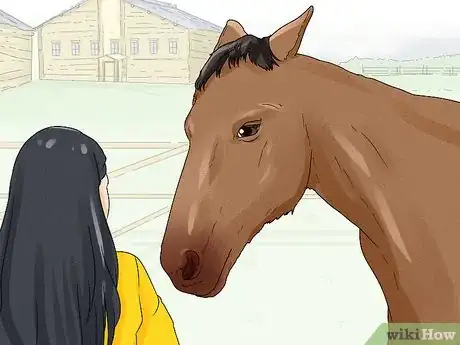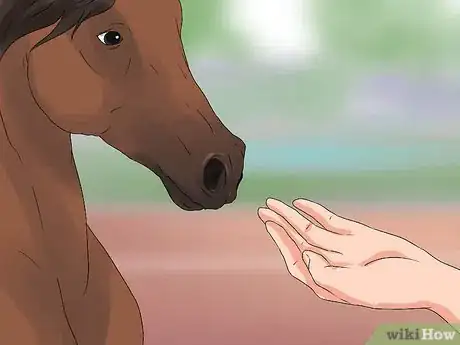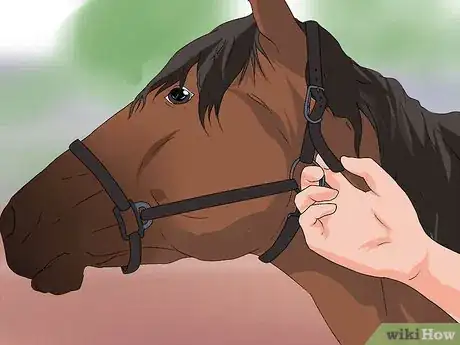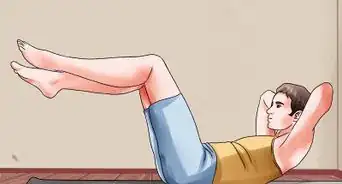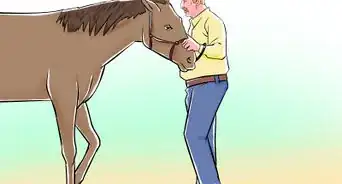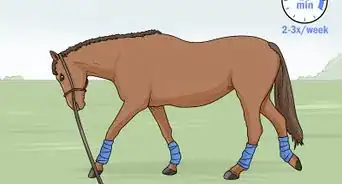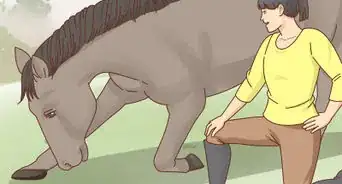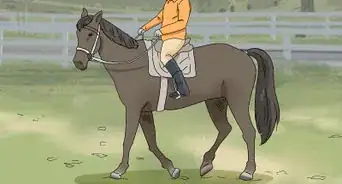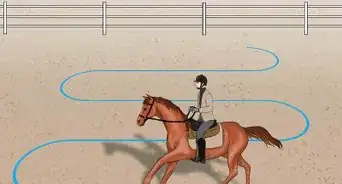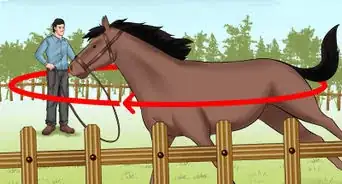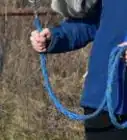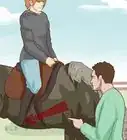This article was co-authored by Kate Jutagir and by wikiHow staff writer, Amber Crain. Kate Jutagir is an Equestrian Specialist, Hunter/Jumper Trainer, and the Owner of Blackhound Equestrian, a premier training barn located on 65 acres in Castro Valley, California. Originally designed to be a riding school used as a springboard for dedicated students into careers in the sport, Blackhound Equestrian has grown into a hunter/jumper training program for all levels focusing on providing a solid foundation needed for personal advancement in the sport. Kate has over 25 years of equestrian instruction and training experience. Her focus on developing horse and rider partnerships provides a complete equestrian education for both beginners and advanced riders alike.
There are 10 references cited in this article, which can be found at the bottom of the page.
This article has been viewed 113,655 times.
Putting a halter on a horse makes it easy for you to lead and train it. If you've never haltered a horse before, the first time can be a bit intimidating! For a smooth experience, remember to approach your horse calmly and reassure it along the way. Make sure the halter is buckled properly and always double-check the fit before you lead the horse. If you have a shy or untrained horse that isn't cooperating, don't worry! Limit practice sessions to 10-15 minutes and stick with it until your horse adjusts.
Steps
Approaching the Horse
-
1Unbuckle the halter and attach the lead before approaching the horse. Unbuckling the halter before you get near your horse can help the process go more smoothly. Unbuckle or unsnap the crown piece, which is the halter strap that goes behind the horse's ears. Then, clip the lead line to the ring at the bottom of the halter's noseband.[1]
- The noseband is at the end of the halter and fits around the horse's nose.
- Horses tend to get nervous when they're introduced to something new. Fiddling with buckles and ropes after you walk up to it may make your horse jumpy or scare it off.[2]
-
2Walk up to your horse from the front so you don't spook it. Approach your horse head-on at a normal pace so it has plenty of time to see and hear you. Come in from the front left at an angle, if you can; experts say horses prefer this approach. Say the horse's name or murmur soothing words as you get close so your horse won't be spooked or caught off-guard.[3]
- Horses have monocular vision, which means they have blind spots in front of their nose, under their head, and in their rear. Sudden sounds or movements, especially in their blind spots, can frighten them.
- Avoid approaching your horse from behind unless you absolutely have to. Horses don't like surprises![4]
Advertisement -
3Let your horse sniff your hand and gently stroke its neck to calm it. Continue speaking to your horse in a soft voice to keep it calm. Reach out your right hand and let your horse sniff it. Then, put your hand on its shoulder or neck and stroke it softly.[5]
- Avoid making any sudden movements or touching its head immediately since you might startle the horse. It's best to work up to things slowly since horses like to be fully aware of everything happening around them.[6]
- If your horse seems calm and happy, you're all set to give the halter a try. If it seems nervous, keep stroking it and speaking softly. Don't try to halter your horse until it's calm.[7]
- Pay attention to its ears since horses tend to put their ears back when they're angry or upset. If your horse's ears are tilted forward, it's calm and listening to you.[8]
-
4Try again tomorrow if your horse seems nervous or afraid. If your horse isn't calm, don't try to halter it yet. For the first couple of days, simply hold the halter so your horse can see it while you're petting it. Let your horse sniff the halter, too, so it gets used to the way it smells. Then, try gently slipping the halter over its nose and ears. It may be a few days before you get the halter on the horse and buckled properly! Go slow and take off the halter if your horse gets upset.[9]
- Limit halter sessions to 10-15 minutes at a time so your horse doesn't get overwhelmed. Try to be patient and let the horse go at its own pace. Otherwise, your horse might start associating the halter with feeling overwhelmed or scared.
- End practice sessions positively by offering treats, speaking encouraging words, and stroking the horse's neck.[10]
Securing the Halter
-
1Stand on the horse's left side with the halter in your left hand. Halters are designed to be buckled on the left, so walk around to your horse's left side and stand near the side of its head. Gently stroke the horse's neck a few times with your right hand to make sure it knows you're there and to soothe it.[11]
- If your horse flares its nostrils or swishes its tail around, it's agitated or scared. Spend a few more minutes soothing it. If the tail swishing continues, don't try to halter your horse today.[12]
- Be especially wary if you can see the whites of your horse's eyes or if its showing you its teeth. This means your horse is pretty upset! It might kick you or try to run.[13]
-
2Slip the lead line loosely around the horse's neck. Pull the end of the line over the top of your horse's neck and reach underneath its head to grab the end. Hold both ends of the rope in one hand so the rope forms a noose around the horse's neck.[14]
- This gives you some control if your horse gets impatient or tries to run away as you're haltering it.
- Avoid tying the ends of the rope together since this can make the horse feel trapped. Keep the rope loose so it doesn't squeeze the horse's neck.[15]
-
3Place the halter over the horse's nose and guide it up to the cheekbone. Make sure the halter's noseband is facing the same direction that your horse is facing so you can slip it on easily. Then, grasp the horse's nose gently with your right hand and use your left hand to gently guide the halter over its nose and up to its cheekbone.[16]
- If the horse gets antsy or frightened with the halter over its nose, take the halter off. You can try again tomorrow![17]
- If the noseband brushes against the large hairs on your horse's nose, it can tickle a bit! This can make your horse shy away from the halter, so try to avoid nudging these hairs if you can.[18]
-
4Slip the crown piece behind the horse's ears with your right hand. Grasp the crown piece of the halter in your right hand. Then, lift the crown piece strap over your horse's neck and behind its ears.
- Gently bend your horse's ears back to get the crown piece over them if you need to.
- Straighten or adjust the crown piece if it's cutting into the horse's ears.
-
5Use both hands to buckle the halter loosely on your horse's left side. Once the halter is on, buckle up or snap the crown piece to secure it on your horse's left cheek. Make sure the buckle is snug enough that the halter can’t be pulled over the horse's ears, but it shouldn't be so tight that the straps are cutting into the horse's skin.[19]
-
6Adjust the straps and buckle so the halter fits properly. The noseband should fall 2 in (5.1 cm) below the bony part of the horse's cheekbone. Make sure you can fit 2 fingers under the noseband and 2 fingers between the buckle and your horse's cheek. Adjust the noseband, chin strap, or buckle, as needed, until everything fits properly.[20]
- Some halters have adjustments on each side of the crown piece, too.
- If the noseband is too tight, your horse won't be able to open its mouth.[21]
- The halter should not put any pressure behind the horse's ears.[22]
- If the halter still isn't fitting properly after adjustments, it's too small and you need to size up.
-
7Grab the lead line near the horse's chin once the halter is in place. Use your right hand to grab the lead line 1–2 ft (0.30–0.61 m) from the horse's muzzle. Then, fold or coil the remainder of the lead line loosely and hold it in your left hand. You're ready to safely lead your horse while its wearing its halter![23]
- Never wrap or tie a lead line rope around your hand. If your horse strains against the halter or tries to run, this can injure your hand pretty badly.
- It's not a good idea to turn your horse loose when it's wearing a halter since the halter could catch on a tree branch or fence.[24]
Expert Q&A
-
QuestionHow do you train a horse for a halter?
 Kate JutagirKate Jutagir is an Equestrian Specialist, Hunter/Jumper Trainer, and the Owner of Blackhound Equestrian, a premier training barn located on 65 acres in Castro Valley, California. Originally designed to be a riding school used as a springboard for dedicated students into careers in the sport, Blackhound Equestrian has grown into a hunter/jumper training program for all levels focusing on providing a solid foundation needed for personal advancement in the sport. Kate has over 25 years of equestrian instruction and training experience. Her focus on developing horse and rider partnerships provides a complete equestrian education for both beginners and advanced riders alike.
Kate JutagirKate Jutagir is an Equestrian Specialist, Hunter/Jumper Trainer, and the Owner of Blackhound Equestrian, a premier training barn located on 65 acres in Castro Valley, California. Originally designed to be a riding school used as a springboard for dedicated students into careers in the sport, Blackhound Equestrian has grown into a hunter/jumper training program for all levels focusing on providing a solid foundation needed for personal advancement in the sport. Kate has over 25 years of equestrian instruction and training experience. Her focus on developing horse and rider partnerships provides a complete equestrian education for both beginners and advanced riders alike.
Equestrian Specialist & Trainer First just bring the halter with you; maybe the first few times you don't necessarily put it on. You could probably start using some treats, so the horse can associate the halter with a really delicious snack. And then just go slowly. Make sure that you're supervised and the horse is supervised, if necessary, because you don't want anything to be caught on a fence post or a stall or anything like that. Take your time, go slowly, and you can put parts of the halter on. You could start with a grooming halter that doesn't have all of the buckles and everything that would make a horse feel restricted. And once the halter is on, give them a treat, make sure they know that that is what you want. And then when you're taking the halter off, it's incredibly important to go slowly. Horses are very sensitive to anything that moves quickly behind their eyes or their head.
First just bring the halter with you; maybe the first few times you don't necessarily put it on. You could probably start using some treats, so the horse can associate the halter with a really delicious snack. And then just go slowly. Make sure that you're supervised and the horse is supervised, if necessary, because you don't want anything to be caught on a fence post or a stall or anything like that. Take your time, go slowly, and you can put parts of the halter on. You could start with a grooming halter that doesn't have all of the buckles and everything that would make a horse feel restricted. And once the halter is on, give them a treat, make sure they know that that is what you want. And then when you're taking the halter off, it's incredibly important to go slowly. Horses are very sensitive to anything that moves quickly behind their eyes or their head. -
QuestionIs it okay to skip some of the steps with trained horses who are used to being haltered?
 wikiHow Staff EditorThis answer was written by one of our trained team of researchers who validated it for accuracy and comprehensiveness.
wikiHow Staff EditorThis answer was written by one of our trained team of researchers who validated it for accuracy and comprehensiveness.
Staff Answer wikiHow Staff EditorStaff AnswerYes! Many horses won't require practice sessions or a lengthy training process. If your horse is trained and you're haltering for the first time, follow the basic steps to learn the technique.
wikiHow Staff EditorStaff AnswerYes! Many horses won't require practice sessions or a lengthy training process. If your horse is trained and you're haltering for the first time, follow the basic steps to learn the technique. -
QuestionMy horse keeps taking off his halter. Help!
 wikiHow Staff EditorThis answer was written by one of our trained team of researchers who validated it for accuracy and comprehensiveness.
wikiHow Staff EditorThis answer was written by one of our trained team of researchers who validated it for accuracy and comprehensiveness.
Staff Answer wikiHow Staff EditorStaff AnswerIf your horse is able to take off its halter by itself, the halter is too loose. Try adjusting the straps and buckles to make the halter a little tighter. If that doesn't work, you may need to buy a smaller halter for your horse (halters come in many sizes).
wikiHow Staff EditorStaff AnswerIf your horse is able to take off its halter by itself, the halter is too loose. Try adjusting the straps and buckles to make the halter a little tighter. If that doesn't work, you may need to buy a smaller halter for your horse (halters come in many sizes).
Warnings
- Be careful to adjust the halter so it doesn't touch the horse's eyes.⧼thumbs_response⧽
- Avoid punishing your horse or being aggressive if the session isn't going well. You don't want your horse to associate the halter with anything negative.⧼thumbs_response⧽
References
- ↑ http://www.horses-and-ponies.com/horse-care/basic/how-to-halter-a-horse-or-pony/
- ↑ https://nasdonline.org/1039/d000837/approaching-catching-and-haltering-horses-safely.html
- ↑ https://nasdonline.org/1039/d000837/approaching-catching-and-haltering-horses-safely.html
- ↑ https://www.hcbc.ca/wp-content/uploads/2015/07/ApproachingCatchingandHalteringaHorsecourse.pdf
- ↑ https://nasdonline.org/1039/d000837/approaching-catching-and-haltering-horses-safely.html
- ↑ https://www.hcbc.ca/wp-content/uploads/2015/07/ApproachingCatchingandHalteringaHorsecourse.pdf
- ↑ https://www.hcbc.ca/wp-content/uploads/2015/07/ApproachingCatchingandHalteringaHorsecourse.pdf
- ↑ https://www.fei.org/stories/lifestyle/health-fitness/10-facts-horses-hearing
- ↑ https://www.uaex.edu/farm-ranch/animals-forages/horses/Halter%20Breaking%20Your%20Horse.pdf
- ↑ https://www.uaex.edu/farm-ranch/animals-forages/horses/Halter%20Breaking%20Your%20Horse.pdf
- ↑ https://www.youtube.com/watch?t=27&v=fV0ahNmovMc&feature=youtu.be
- ↑ https://horses.extension.org/horse-body-language/
- ↑ https://www.rspca.org.uk/adviceandwelfare/pets/horses/behaviour/bodylanguage
- ↑ https://extension.missouri.edu/publications/g2844
- ↑ https://nasdonline.org/1039/d000837/approaching-catching-and-haltering-horses-safely.html
- ↑ https://www.hcbc.ca/wp-content/uploads/2015/07/ApproachingCatchingandHalteringaHorsecourse.pdf
- ↑ https://www.uaex.edu/farm-ranch/animals-forages/horses/Halter%20Breaking%20Your%20Horse.pdf
- ↑ https://nasdonline.org/1039/d000837/approaching-catching-and-haltering-horses-safely.html
- ↑ https://www.hcbc.ca/wp-content/uploads/2015/07/ApproachingCatchingandHalteringaHorsecourse.pdf
- ↑ https://extension.missouri.edu/publications/g2844
- ↑ https://nasdonline.org/1039/d000837/approaching-catching-and-haltering-horses-safely.html
- ↑ Kate Jutagir. Equestrian Specialist & Trainer. Expert Interview. 31 March 2020.
- ↑ https://www.hcbc.ca/wp-content/uploads/2015/07/ApproachingCatchingandHalteringaHorsecourse.pdf
- ↑ https://nasdonline.org/1039/d000837/approaching-catching-and-haltering-horses-safely.html
About This Article
To halter a horse, start by positioning the halter so it's facing the same way as the horse, with the nose band next to its nose. Next, loop the lead rope around its neck so you have some control if it runs away. Then, guide the halter over the nose and ears, and buckle it in place. If your horse seems nervous or afraid, try speaking in a soothing voice while petting it to help it calm down. For tips on how to approach your horse safely before putting on a halter, keep reading!

